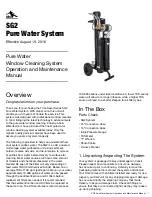
SG2 Pure Water System Operation and Maintenance Manual - 3
4. Hooking Up To Water Source
Your SG2 is designed to be operated while standing up.
Locate an external water source. Attach one end of the
feed hose (not supplied) to the water source. ¾” garden
hose is preferred. Open the faucet at the building
and make sure all air is out of your source hose. Turn
off water and attach to the female connection on the
Carbon/Sediment filter. Turn water back on fully and
adjust bypass valve to desired flow rate.
Ensure the system is unpressurized by fully opening
the bypass valve and the RO only valve. Failure to do
so could result in injury as the pressure is released or
create a vacuum that will hold the old RO membrane
in place. Remove the yellow wedge piece from the top
of the RO housing with a phillip’s screwdriver, then
remove the white retaining ring by pulling it out of the
groove around the inside of the housing. Remove the
black cap from the top of the filter housing using the
“T” wrench. Insert the wrench into the threads on the
top of the housing and lift up to remove the cap. There
is an o-ring underneath the black cap, remove and
inspect this for any cracks or signs of wear. Replace if
necessary (part number FW7000-COR). Using a pair
of needle nosed pliers, remove the old RO membrane
from the housing by lifting it up. Apply a small amount
of Molykote 111, or similar silicone grease, to the top
and bottom protrusions on the new RO membrane.
Also apply Molykote 111 to the white rubber sealing
ring on the new membrane - this white ring will be on
the upper end of the filter when it is properly installed
in the housing. Insert the new RO membrane into the
housing by pushing it down and into the o-rings on the
bottom of the assembly. Coat the o-ring with molykote
and insert into shelf on the top of the RO housing.
Insert the black cap on the top of the housing by
pushing it down below the retaining groove. Insert the
white retaining ring in the retaining groove. Ensure the
white retaining ring is properly seated and reinstall
the yellow retaining wedge. Both of these keep your
pressure vessel top from shooting off.
RO Filter
5. Bypass Valve Operation
The system comes with a Bypass/Pressure Regulator
valve. The bypass valve is the primary way you can
control the pressure of your system. It also controls
the amount of water that your RO membranes lose
as bypass discharge during normal operation. There
should always be water flowing out of the bypass
valve. Opening the bypass valve more will reduce the
amount of pressure that is used to produce pure water,
resulting in lower flow rates at the brush. Closing the
bypass valve will increase the amount of pressure
which can lead to higher flow rates at the brush, but
can diminish the life of the filter. RO membrane filters
use the bypass flow to remove concentrated dissolved
solids from the filter. Operating the system with the
bypass open (until the bypass flow is approximately
the same as the pure water flow) is one of the best
ways to ensure maximum life from the RO membrane
filters. Closing your valve so that the flow of the bypass
is roughly equal to the flow of pure water is a good
place to start. This will restrict flow for elevated system
pressure, but also allows some brine to exit your
membranes. It is recommended that you run your
system with the bypass valve fully open for a few
minutes each time you finish using your system to
help clean out your RO membranes and help extend
their life.


























